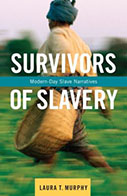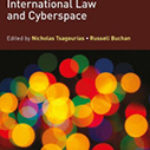Survivors of Slavery: Modern-Day Slave Narratives

Author: Laura T. Murphy
Publisher: New York: Columbia University Press, 2014. 344p.
Reviewer: Anne Johnston | May 2015
Over the past several years, when U.S. news media report on human trafficking, the result is an over simplistic and sometimes sensationalized crime narrative. Trafficking is typically reported as an event…a breaking news story about an arrest or a raid, or sometimes an announcement about the passage of a new law to combat trafficking. There is typically not much background given about the issue, nor is there much context in which to understand the how and why of this issue. The sources quoted in the stories tend to be law enforcement or public officials.
Understanding the historical and cultural context and setting for trafficking is critical to appreciating the magnitude of this issue. And including the survivors’ voices becomes important in understanding the multiple standpoints that make up the narrative of trafficking.
This book by Laura T. Murphy is a welcome addition to our understanding of trafficking. It helps move the ‘story’ of trafficking from an event-driven crime narrative to a more nuanced and contextualized human rights narrative. As Murphy argues early in the book, “[a]s many of the narrators insist, the first hand accounts of survivors of slavery are crucial for any informed discussion of the issue, and to the formation of policies and practices that respond to it” (pg. 6). The standpoints and information offered here, from the forewords by Kevin Bales and Minh Dang, to the slave narratives themselves, to Murphy’s contextualizing the narratives into themes of modern-day slavery, all help provide a much clearer picture of a modern manifestation of a very old problem.
The author is well suited to provide this perspective — she brings the ability to critique literature and narratives as an English professor. In addition, her roles as the Director of the Modern Slavery Research Project at Loyola, and as director of the Survivors of Slavery speakers network, give her access to the stories of modern slavery.
Murphy outlines two goals for the book: one, to provide the narratives of slavery survivors in order to engage audiences to become active in eliminating modern day slavery; and two, to investigate the narratives as documents that help understand and inform modern slavery/slave narrative studies.
Early in Survivors of Slavery, Murphy defines slavery, provides statistics on modern-day slavery, and provides the historical context for understanding the importance of slave narratives, both past and present. There is a clear argument that these modern cases of bondage should indeed be identified as slavery. Although she acknowledges differences in historical and modern slavery, she addresses head on, the debate about the use of the term slavery in the context of these modern conditions for slavery. The author argues that “it is the forced extraction of labor for another person’s profit that is essential in defining slavery” (p. 14.), not necessarily ownership and purchase. Scholars can certainly disagree with the use of the term slavery for anything other than bondage and ownership, but to her credit, Murphy directly addresses the methods by which she hopes to relate modern slavery to past slavery.
Another controversy that Murphy addresses is the linking of all sex work to slavery or sex trafficking. She argues that politicians who try to link this are attempting to mobilize public opinion against sex work. The case she makes is a good one in calling for precision in how media cover and describe sex work, prostitution and sex trafficking. The point made here is an important one — news media should use language and terms carefully, striving for precision and accuracy in discussions of sex trafficking. One area not addressed in the book that might be considered for perhaps a second edition, is acknowledging the different viewpoints on this issue among sex workers themselves. There are current and former sex workers who have argued that the focus on all forms of sex work being equated with sex trafficking has led to the arrest and harassment of sex workers. But there are other current and former sex workers who just as strongly make the argument that in fact they did not have true freedom to choose to do sex work, did not keep the money they made, and indeed therefore were victims of forced (sex) labor.
The narratives from survivors of slavery provide the real heart of this book. The narratives are first hand accounts and are unedited by professional writers. The narratives come from several sources, including testimonies before legislative bodies or courts, or submitted to immigration offices; interviews with an investigative journalist; stories collected by anti-trafficking organizations; interviews from documentaries; and, stories submitted as original narratives to the author.
Murphy has organized the chapters around the narratives, providing history and context for those chapters. The chapters and the narratives cover a wide range of experiences and topics, such as economic and global issues that lead to vulnerability to work and labor slavery; the romanticization of slaves as being part of a family and the use of family labels and ties to continue to oppress workers; the various legal and economic tools and methods that traffickers and slave holders use to keep people enslaved; the moments and the awakenings when persons who are trafficked realize their enslavement and begin to resist individually and collectively; the silence that is a part of the slave narrative; and finally, how some survivors become activists and work individually and with activist/survivor communities to tell their stories and develop power and strength from their work for others.
This book is not just an effort to showcase modern slave narratives nor to provide a context for understanding those narratives. The book also is a call to action, and provides specific ways that people can become “21st century abolitionists” and fight to end slavery. Detailed advice is given about how to become involved in the anti-slavery movement both at a personal level and at a societal level. To support that advice, lists of anti-slavery organizations are provided in the Appendix.
If we are to increase the accuracy and precision in the reporting of trafficking or slavery, we must include the voices of those most directly affected by trafficking or slavery — the survivors. In her book, Laura Murphy weaves a strong historical and cultural framework for understanding the nature of those standpoints, the diversity of the voices, and the importance of including those perspectives in any political discussion, news commentary or documentary, or any societal debate about the issue.
Anne Johnston, Ph.D.
Professor, School of Journalism and Mass Communication
Co-director, The Irina Project
University of North Carolina at Chapel Hill


